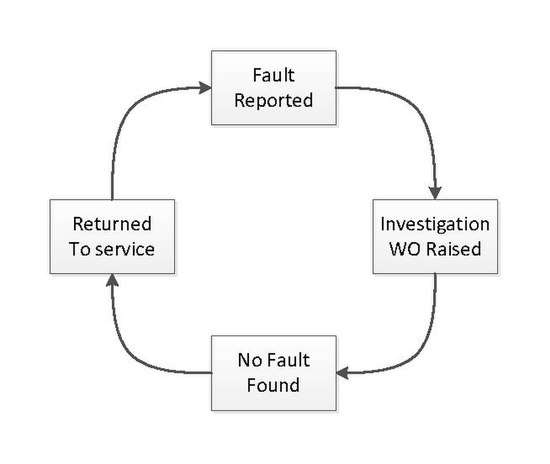No fault found
No fault found (NFF), no trouble found (NTF) or no defect found (NDF) are terms used in the field of maintenance, where a unit is removed from service following a complaint of a perceived fault by operators or an alarm from its BIT (built-in test) equipment. The unit is then checked, but no anomaly is detected by the maintainer. Consequently, the unit is returned to service with no repair performed.[1][2][3]
If there is an underlying fault that has not been detected the unit may be returned for repair several times with no fault identified. Alternative descriptors include:[4]
- No fault found (NFF)
- Cannot duplicate (CND)
- Fault not found (FNF)
- No trouble found (NTF)
- No defect found (NDF)
- Hidden failures
- False failures
The NFF problem

As the figure shows once a fault has been reported, investigated, and no fault found any future problems caused by the fault cause additional work which is a waste of maintainer time. Different causes have been suggested for this issue.
- Some can be attributed to the way a possible fault is perceived by the user.
- Some can be attributed to the diagnostic methods available to the maintainer.
The fact remains that no fault found causes a cost to industry. NFF is thought to cost the United States Department of Defense in excess of US$2 billion per year.[5]
Causes
NTF returns are often caused by the following patterns:
- Service technicians using a "shotgun" approach to troubleshooting when they are unable to quickly diagnose a problem or error. Under time pressure to resolve problems quickly, the technician uses multiple replacement parts in hopes that one of them will fix the issue.
- Inability to distinguish hardware problems from software or configuration issues. For example, a device driver problem may mimic a true hardware problem.
- Intermittent problems.
- Misdiagnosis of the causing component (i.e. investigating a component that could not have caused the defect)
Impact
NTF returns can seriously erode profit margins for manufacturers and service providers. The time, materials, and shipping costs in exchanging hardware is enormous in relation to the cost of the item being replaced. Further, NTF returns can also indicate that customers' problems have not been resolved, and thus imply reduced customer satisfaction and eroded brand value.
Defense
Several methods are available to reduce NTF events:
- Better training for service technicians and call center agents
- Technician compensation structures that emphasize accuracy over speed
- Provision of tools such as diagnostic software to end users or the technicians that can identify the source of problems, and distinguish between software and hardware issues
Example of abuse
NTF reduction must be performed in a thoughtful manner. Reportedly a major PC manufacturer attempted to eliminate NTF returns by charging back the cost of any NTF item to its service organization. This greatly increased the motivation of the service organization to only return defective parts from customer service calls. The goal was quickly met, with only few parts being identified as NTF, though the overall number of parts being returned did not significantly change. An investigation into the suddenly much higher part failure rate discovered that service engineers were routinely causing damage to parts that were being exchanged, so that they would not be liable for the cost of any related NTF event. The NTF charge-back program was quickly abandoned thereafter in this example of unintended consequences.
References
- Söderholm, Peter (January 2007). "A system view of the No Fault Found (NFF) phenomenon". Reliability Engineering & System Safety. 92 (1): 1–14. doi:10.1016/j.ress.2005.11.004.
- James, I.; Lumbard, D.; Willis, I.; Goble, J. (1 January 2003). "Investigating no fault found in the aerospace industry". Reliability and Maintainability Symposium, 2003. Annual: 441–446. doi:10.1109/RAMS.2003.1182029. ISBN 978-0-7803-7717-2.
- Qi, Haiyu; Ganesan, Sanka; Pecht, Michael (May 2008). "No-fault-found and intermittent failures in electronic products". Microelectronics Reliability. 48 (5): 663–674. doi:10.1016/j.microrel.2008.02.003.
- Khan, Samir; Phillips, Paul; Jennions, Ian; Hockley, Chris (March 2014). "No Fault Found events in maintenance engineering Part 1: Current trends, implications and organizational practices". Reliability Engineering & System Safety. 123: 183. doi:10.1016/j.ress.2013.11.003. hdl:1826/9947.
- Werner, Debra (February 2015). "Aerospace America" (PDF) (2). AIAA. Archived from the original (PDF) on 2017-05-10. Retrieved 2020-01-01.